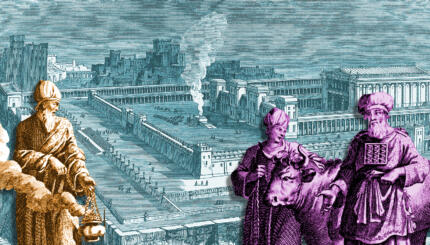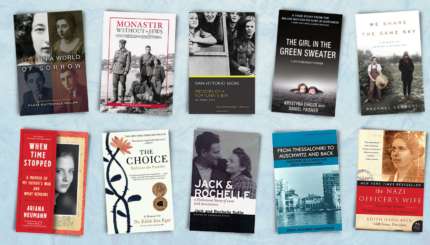In this article Rabbi Greenberg explores the meaningfulness of Yom Hashoah. A related piece in this section, “Early Proposals for Holocaust Commemoration,” provides background for the article below, which is excerpted with permission of the author from The Jewish Way: Living the Holidays.
Earnest Bargaining
For two years [from 1948-50] in the [the Israeli parliament], the two main antagonists over the commemoration bill blocked each other. The turning point came in late 1950, when earnest bargaining began.
The ghetto fighters and their allies wanted a special day, as close to 14-15 Nissan as possible [to mark the beginning of the Warsaw ghetto uprising]. Their terminus ad quem [latest acceptable date] was May 16, the date on which Jurgen Stroop, the German general, declared that the ghetto was totally destroyed.
The Orthodox wanted to push the date as far back as possible from Passover–at the least, into the next month of Iyar (the second Hebrew month) so as not to infringe on the prohibitions of mourning and eulogies in the month of Nissan. If the date could be deferred to the month of Iyar, it would fall within the Sefirat Ha’Omer mourning period [the period between Passover and Shavuot], which would make it less troublingly “innovative” to the current mindset of the authorities.

Help us keep Jewish knowledge accessible to millions of people around the world.
Your donation to My Jewish Learning fuels endless journeys of Jewish discovery. With your help, My Jewish Learning can continue to provide nonstop opportunities for learning, connection and growth.
A Leading Rabbi Holds Fast to Tradition
As the parties jockeyed back and forth, the Orthodox representatives, hoping for some leeway, privately sought out the leading posek (halakhic decisor) of the Orthodox right, a man of towering stature, the Chazon Ish. But the Chazon Ish was unyielding; it was prohibited to disrupt the joy of Nissan with any such public mourning. In effect, the Chazon Ish ruled that not the slightest hair on the head of tradition could be touched for the sake of remembering the Holocaust. The inherited practice was unaffected by historical experience; the halakhah and Judaism remained outside of history, untouched by the flux of time or the sledgehammer blows of the Holocaust.
The Labor Zionist establishment provided the “swing” vote that decided the outcome. They agreed with the Orthodox that Passover should be spared, and they felt that Holocaust Commemoration Day should precede Israel Independence Day, which occurred on the fifth of Iyar.
Reaching A Compromise
Finally, after much negotiating and sparring, the deal was struck (there were even rumors of job trading and other “payoffs” to obtain the necessary agreement, although a number of the key negotiators deny that story to this day). As close to Passover as possible turned out to be 27 Nissan.
For the Orthodox, this was a breach of the unmitigated joyfulness of the month. Setting this date for mourning directly violated a halakhic tradition, albeit a minor one. Indeed, the right-wing Orthodox were so unhappy that they have never accepted this date. (In the late 1980s, elements of the Chasidic and Agudas Israel communities began to participate in Yom Hashoah commemorations in New York City.) There could be no “compromise” of a jot or tittle of the halakhah. To somewhat assuage their feelings, the Orthodox were granted a further concession: If the memorial date fell on Friday or Saturday, it would be postponed until Sunday.
No one was satisfied with the outcome. The Orthodox were unhappy because they had been forced to accept an official day that incorporated a violation of the halakhah. The fighters were unhappy because the commemoration was not on the day of the uprising. There was no significant event or special association with 27 Nissan, and thanks to the protection, the memorial day was not even fixed on the same date every year. But the overall pressures to create a memorial day could no longer be denied. On April 12, 1951, the Knesset declared 27 Nissan as Yom Hashoah U’Mered HaGetaot (Holocaust and Ghetto Revolt Remembrance Day). The day was soon referred to as Yom Hashoah Ve-Hagevurah (Devastation [Holocaust] and Heroism Day). In 1953, the memorial authority was established and named Reshut Zikkaron Yad Vashem (Memory and Memorial Authority).
The truth is that all through the fifties, the day was neglected. Not until 1959 did the Knesset legislate a national public commemoration of the day; two years later it passed a law closing all public entertainment on that day.
Why This Was the Right Decision
Why is 27 Nissan the right day for Yom Hashoah? Had the fighters/partisans gotten their way and 15 Nissan been chosen for the commemoration, this coincidence would have negated the Passover holiday; the joy of Exodus, as it were, would have been buried under the ashes of Auschwitz. Impressing the total experience of destruction on the very day of national liberation would constitute a statement that hope is overwhelmed; redemption has been defeated by catastrophe. In effect, the Nazis would have gained a posthumous victory; their assault on Passover finally would have succeeded.
Furthermore, the message would have been that identification should be made only with the fighters; all the other Jews in the Holocaust were a source of shame, their deaths best played down or forgotten. The implication would have been that the overwhelming might of the Nazis that crushed the victims and killed them beyond their capacity to resist or respond had robbed their deaths of dignity and meaning.
Martyrdom Matters
This judgment would have been a triumph of Western values over the classic Jewish concepts of (sanctification of God’s name) through martyrdom. The idea that death is meaningful only through resistance is a plausible one, but it had already been judged during the Holocaust to be wrong.
As the full extent of the Holocaust revealed itself to the captive Jews of Europe, many recognized that the concept of Kiddush HaShem, martyrdom for God’s sake, might lose its significance. In the Middle Ages, Jewish martyrs had the choice of converting to Christianity and saving their lives or of consciously offering their lives rather than abandoning their God and Torah. In many cases, they had the chance to publicly witness their faithfulness and to state their defiance of those who sought to intimidate them into betrayal.
Kiddush HaShem during the Holocaust
During the Holocaust, however, the Nazis gave no choice. All Jews were killed whatever their intention, practice, or desire. Assimilated Jews and even Jews converted to Christianity were killed. Then what possible connection could there be between the nobility of martyrdom and involuntary death for a cause one does not believe in? Can this be the Nazis’ final triumph, that mass death robs all death of meaning? These questions were posed to Rabbi Menachem Ziemba of Warsaw and to other rabbis.
Rabbi Ziemba and the other rabbis knew better. They ruled that any Jew who was killed because he or she was Jewish was considered to have performed Kiddush HaShem. The truth underlying this ruling is that every Jew carries the covenant in his or her very existence. Whatever the religious behavior or commitment, a Jew’s existence alone is witness to God and covenant.
As long as one Jew is alive, all the associations and testimony of the tradition are summoned up: One God, Messiah-is-not-yet-come, ultimately-we-shall-see-the-triumph-of-life. For this reason, the Nazis sought to destroy every last Jew. Therefore, chosen or not, each death was a statement fraught with meaning. The very need to kill the Jews is, in a way, a statement of how powerful is the message they still radiate.
Mourning All Jewish Victims
A commemoration day on 15 Nissan, defined by armed resistance, would have been a betrayal of this truth of Jewish existence and death in the Holocaust. Pushed off for two weeks, the connection to armed revolt attenuated and obscured, Yom Hashoah became a day of mourning for all Jews who died. The modern bias for intentionality notwithstanding, despite the demand for overtly expressed defiance, all Jews who died in the Holocaust are martyrs; all witnessed with their lives and deaths.
In fact, the Holocaust is increasingly revealed as the fundamental watershed in Jewish and human history after which nothing will ever be the same. It is one of those reorienting moments of Jewish history and religion when basic conceptions of God, of humanity, and of Jewish destiny shift.
Yom Hashoah and Yom Ha’atzmaut
As the commemoration day now stands, Passover joy is shadowed by Yom Hashoah. In effect, Passover is wounded but not destroyed, which is the truth witnessed by Jewish life after the catastrophe. Wounding but not destroying Passover is another way of saying the covenant is broken but not defeated or replaced.
Had the Orthodox gotten their way in the final negotiations, Yom Hashoah would have been deferred to the month of Iyar or beyond. Had that happened, there would have been no connection between Yom Hashoah and Yom Ha’atzmaut. But, in fact, Yom Ha’atzmaut is the fundamental response to Yom Hashoah.
Now Yom Hashoah occurs one week away from Yom Ha’atzmaut, and nothing could more profoundly capture the fundamental relationship of Holocaust and Israel than that positioning. The State of Israel is not a reward or a product or an exchange for the Holocaust; it is a response. The Jewish people responded to the total assault of death by an incredible outpouring of life. The survivors came and rebuilt their lives. Jewish life was made precious again. The great biblical symbol that, according to the prophets, would some day prove that the covenant had endured is the reestablishment and repopulation of the land of Israel.



